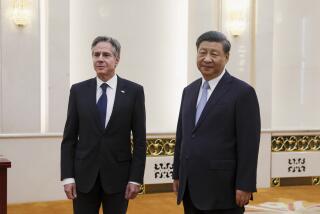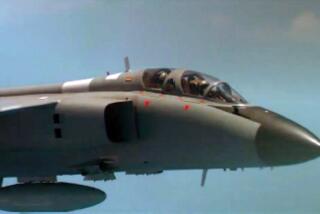U.S. Meets With Detained Crew as Tensions Mount
- Share via
BEIJING — U.S. diplomats met late Tuesday with crew members of an American spy plane for the first time since the aircraft landed in China two days earlier, but there was no indication that the meeting would lead to their release or an end to a diplomatic standoff between Washington and Beijing.
The 24 crew members of the Navy EP-3 reconnaissance plane appeared to be in good condition when they met with two diplomats for 40 minutes on Hainan island off southern China.
But U.S. officials in Washington said the Chinese had begun an intense examination of the plane, despite American demands that they leave the plane untouched. And the Chinese insisted that the United States apologize for the spy flight, a move American officials have said they will not make.
President Bush slightly sharpened his tone about the incident, warning Tuesday that it had “the potential to undermine our hopes for a fruitful and productive relationship between our two countries.”
“It is time for our servicemen and women to return home. It is time for the Chinese government to return our plane,” Bush said in brief remarks at the White House.
The EP-3, on patrol about 65 miles southeast of Hainan, was damaged Sunday when it collided with a Chinese F-8 fighter jet. The Chinese aircraft went down, and the pilot was still missing. The U.S. plane was forced to land on Hainan.
U.S. authorities say the collision was accidental. A senior Bush administration official said it was clear after the meeting with the crew that the plane was “in extremis” when it landed. It had lost the use of one propeller, a second propeller and the nose were damaged, and the pilot had no indication of airspeed.
“If anything qualifies as an emergency landing, this certainly does,” the official said.
U.S. Ambassador to China Joseph W. Prueher said on CNN’s “Larry King Live” on Tuesday night that the EP-3 was too damaged to be flyable.
Beijing, meanwhile, showed no sign of backing off, maintaining that the Navy plane caused the accident and had violated China’s sovereign airspace.
Chinese President Jiang Zemin said there was “sufficient evidence” to show that the U.S. was at fault, and he called on America to stop sending surveillance missions so close to his nation.
Chinese Foreign Ministry spokesman Zhu Bangzao said the U.S. “should face the facts squarely, shoulder responsibility and apologize to the Chinese side.”
But the senior U.S. official, who requested anonymity, said “there’s nothing to apologize for.”
In San Diego, acting Secretary of the Navy Robert B. Pirie Jr. said the U.S. will not be intimidated by the incident into discontinuing intelligence-gathering flights. He also indicated that no apology is necessary.
“This airplane was clearly in international airspace when this occurred,” Pirie told reporters aboard the 3rd Fleet command ship Coronado. “We are going to continue to establish freedom of navigation everywhere we are authorized to do it by international law.”
Chinese officials said they reserved the right to conduct their own investigation of the collision, including an inspection of the U.S. craft.
On Tuesday, Beijing released more details of its version of what happened.
At 8:36 a.m. Sunday, China dispatched two F-8 fighter jets to shadow the EP-3, which had been detected off Hainan. The two fighters flew parallel to the EP-3, about 400 yards to one side, Zhu said. Half an hour later, at 9:07, the EP-3 suddenly “veered at a wide angle toward the Chinese planes” and rammed its nose and left wing into the tail of one of the fighters, which lost control, plummeting to the ocean below, Zhu said. Its pilot, Wang Wei, ejected out of his plane but has not yet been found.
The second F-8 returned to its base safely at 9:23, and the EP-3 limped into the Lingshui military air base on Hainan 10 minutes later.
China Says No Mayday Was Issued
Zhu said there was no record that the EP-3 had issued a mayday call, which China said is necessary before a disabled plane can land in a foreign country.
But U.S. defense officials said the aircraft had transmitted the international distress signal before arriving on Hainan, thus doing all that is required under international rules before a plane makes an emergency landing at the nearest runway.
Secretary of State Colin L. Powell, asked about the claim by the Chinese that they have a right to investigate the incident, said he did not “know what there is to investigate. Our plane was flying in international airspace. Their planes were in international airspace. An accident occurred.”
Powell said the Americans should be released at once. “That crew is still in detention,” he told reporters on a flight from Key West, Fla., to Washington. “They are being held incommunicado under circumstances that I don’t find acceptable.”
Bush, in his remarks, said he wanted to give China time to respond to the weekend episode, to prevent the stalemate from deteriorating into a full-fledged crisis. But he said such a grace period was running out.
The president said he had talked to Army Brig. Gen. Neal Sealock, the U.S. Embassy defense attache in Beijing, who met with the crew, which consists of 22 Navy personnel, a Marine and a member of the Air Force.
Chinese officials were present during the meeting, a U.S. official said, and the general was denied the opportunity to meet with individual crew members or to speak to them without the Chinese present.
The crew members were being held in what was described as a military guest house or hostel, with two to a room. The pilot was given a private room, a senior U.S. official said.
Since the aircraft landed, U.S. military officials have been more visible and forceful than their civilian counterparts in insisting that the crew members and the plane be released.
But aides said Bush and his senior administration officials were being purposely cautious in hopes of making it easier for the Chinese to back down.
Powell said of the meeting between U.S. officials and the crew.: “I hope that is the beginning of an end to this incident. Let’s get to other matters and put this behind us.”
Richard L. Armitage, the deputy secretary of State, summoned Chinese Ambassador Yang Jiechi to discuss the matter, a senior U.S. official said.
A U.S. official who asked to remain unidentified said the Chinese were swarming over the plane in a way that suggested “they know they’ve got hold of something with real value.” The Chinese have apparently moved a tarpaulin over at least a portion of the aircraft, suggesting that they have removed some exterior panels in an effort to examine the mechanisms inside.
The EP-3, a four-engine propeller plane, belongs to a class of long-range anti-submarine warfare patrol aircraft. Its equipment, which allows the U.S. to pick up such small electronic data as faxes and e-mails, would be a treasure trove to the Chinese.
But the crew members had between 15 and 20 minutes before landing, according to estimates made Tuesday, and they may have been able to destroy a good deal of the sensitive material in that time, defense officials said.
Meanwhile, a report in the Taipei Times in Taiwan said the EP-3 did not send out a mayday signal. Citing an unnamed intelligence source who purportedly monitored the incident by radar and listened to cockpit exchanges, the newspaper said the EP-3 had been shot at by a second F-8 after the one involved in the collision went down.
The report said the two fighters had been shadowing the U.S. craft as it circled, checking out a Sovremenny-class naval destroyer the Chinese had purchased from Russia. While attempting to tail the slower-moving EP-3, one of the fighters turned, bumped into the U.S. plane and crashed into the sea. As the unarmed EP-3 headed away, the other F-8 fired a warning shot, then possibly forced the American craft to land on Hainan, the newspaper said.
At a briefing, Rear Adm. Craig Quigley, the chief Pentagon spokesman, disputed that shots had been fired. There was “absolutely no evidence that that was the case,” he said.
Plane Needed to Land Immediately, U.S. Says
Some observers have raised questions about whether the plane should have flown to a friendly air base after the collision. But a senior U.S. defense official said the damage to the EP-3 was more serious than had been earlier believed, making it necessary for the plane to land as soon as possible at the closest airport.
Apparently concerned about how the incident may be appearing to international audiences, the Pentagon asked news reporters to stop calling the EP-3 a “spy plane” and its crew members “spies.”
Though the plane is capable of collecting military radio and radar communications, Quigley said it is more properly described as a “reconnaissance” aircraft because it does not operate covertly.
“This was overt reconnaissance, carried out in international airspace, under international rules,” he said.
Taiwanese leaders have been nervously watching the drama unfold between their most powerful supporter, the U.S., and their biggest rival, mainland China, which claims the island as part of its territory.
The Taiwanese are especially concerned over the effect the incident will have on impending U.S. arms sales to their government. The Taiwanese military has asked for sophisticated tracking devices and several naval destroyers to augment its forces. Beijing strongly opposes foreign arms sales to the island.
Although China says it is up to the U.S. to resolve the dispute by giving a full explanation of the collision, Beijing has compelling reasons to bring the matter to an end in a timely fashion.
The United Nations is just days away from a vote on whether to condemn China’s human rights record. Also, the International Olympic Committee is expected in July to announce the winning bidder to host the 2008 Summer Games, which Beijing desperately covets. The government is acutely aware that any tarnish on its image would lessen its chances to host the Games.
And with Chinese accession to the World Trade Organization not yet a done deal, the Communist regime faces another vote in the U.S. Congress over whether normal trade ties with Beijing will be renewed, a yearly exercise that greatly irritates the government here.
*
Chu reported from Beijing and Richter from Washington. Times staff writers Tony Perry in San Diego, James Gerstenzang, Edwin Chen and Norman Kempster in Washington and special correspondent Anthony Kuhn in Beijing contributed to this report.
More to Read
Sign up for Essential California
The most important California stories and recommendations in your inbox every morning.
You may occasionally receive promotional content from the Los Angeles Times.












